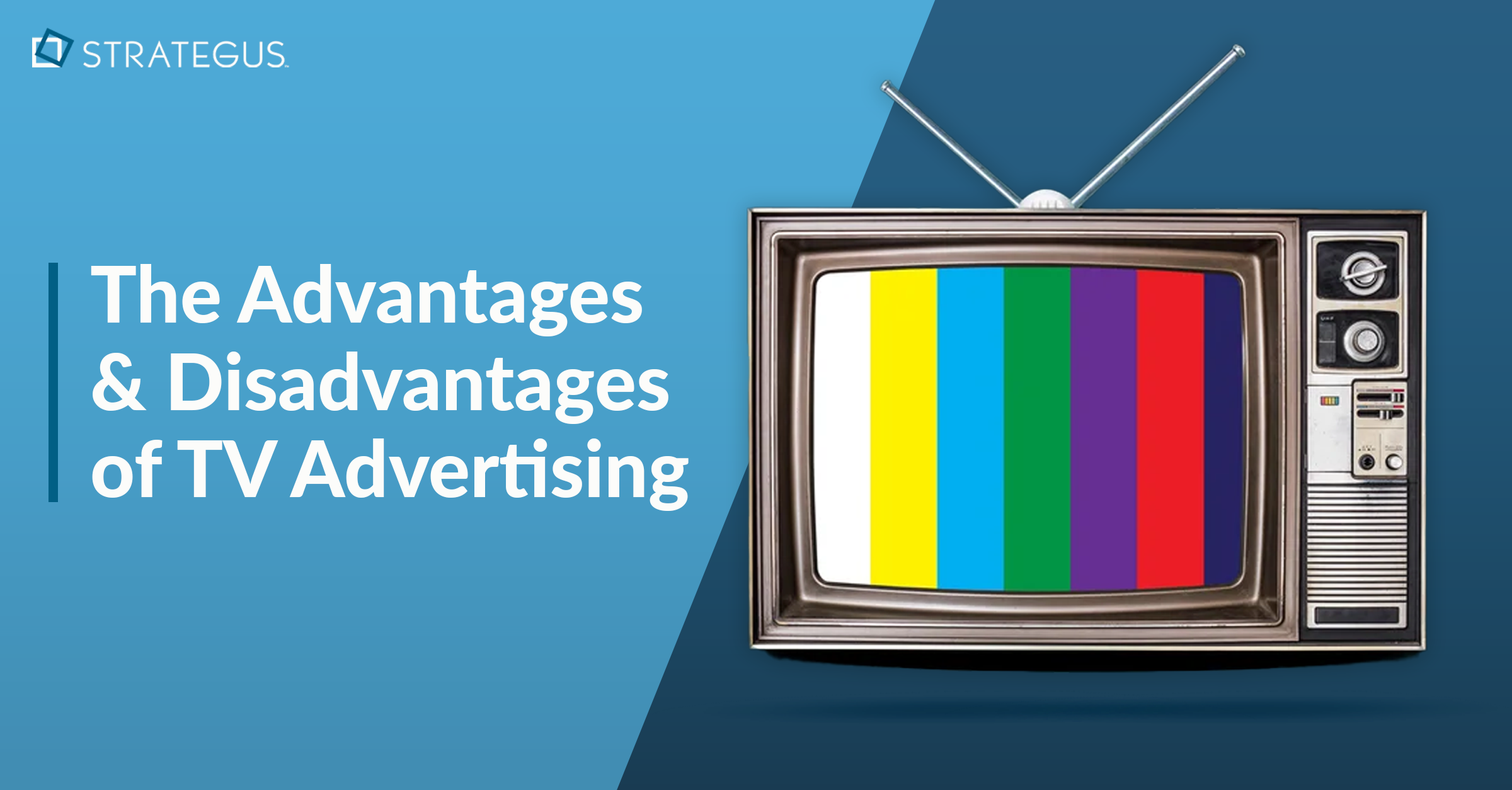- Home
- Strategus Blog
- The Advantages and Disadvantages of TV Advertising
The Advantages and Disadvantages of TV Advertising
 Traci Ruether
Traci Ruether
13 minutes read

Chances are you remember a few iconic commercials from childhood. For me, the Budweiser ‘Wassup’ campaign comes to mind. It was embedded in early 2000s pop culture, airing during Super Bowl XXXIV and even inspiring a scene in Scary Movie.
The Wassup campaign captured the benefits of TV advertising:
- It was memorable (thanks to the big-screen multimedia impact)
- It evoked emotion (through comedic storytelling)
- It connected viewers (with a shared joke that we were all in on)
- It established brand credibility (by running alongside premium content)
Despite the ways that TV consumption has changed through the years, the advantages of advertising on it remain the same. And in many ways, there’s even more upside for brands today due to the fact that many households have cut the cable cord in favor of streaming TV.
Source: Nielsen
Due to this shift, TV advertising now comes in a couple different flavors: traditional TV and connected TV (CTV) advertising. So what are the pros and cons of traditional TV advertising and how does this compare to CTV advertising?
The TL;DR is that CTV capitalizes on the best aspects of traditional TV advertising while also overcoming many of its limitations. Keep reading for the full rundown.
Benefits of TV Advertising

As far as ads go, it doesn’t get much better than those playing on living room TV. Commercial breaks have always been embedded into the TV viewing experience, and the very best ads entertain us much like the programming itself.
From the funny commercials to the heartstring pullers to everything in between, this storytelling capability is what makes TV ads so impactful. It’s also why the best TV ads leave a lasting impression that translates to business results.
Going back to Budweiser’s Wassup campaign, its success went beyond brand lift. Specifically:
- Sales increased by 2.4%, reversing a 10-year decline
- The campaign generated an estimated $20 million in free publicity through appearances in TV stories and news articles
While few campaigns will achieve this level of success, it's evidence of the many benefits of TV advertising that other channels simply can’t reproduce.
Advantages of TV Advertising
 Premium and credible: TV advertising places your brand on the largest screen in the household, capturing viewers’ full attention. These ads run alongside premium content that’s professionally produced, which is a stark contrast from the ads placed on social media sites or across the web. As a result, TV advertising helps enhance brand perception and establish credibility.
Premium and credible: TV advertising places your brand on the largest screen in the household, capturing viewers’ full attention. These ads run alongside premium content that’s professionally produced, which is a stark contrast from the ads placed on social media sites or across the web. As a result, TV advertising helps enhance brand perception and establish credibility.
 Multimedia storytelling: With sight, sound, and motion, TV ads bring brands to life — thereby making a memorable impact. There’s simply no better way to tell a brand story and build emotional connection with top-of-funnel prospects.
Multimedia storytelling: With sight, sound, and motion, TV ads bring brands to life — thereby making a memorable impact. There’s simply no better way to tell a brand story and build emotional connection with top-of-funnel prospects. Broad reach and exposure: The impact of TV advertising on pop culture is undeniable. And a major reason for this is because it connects advertisers with massive audiences, making it a great channel for awareness campaigns.
Broad reach and exposure: The impact of TV advertising on pop culture is undeniable. And a major reason for this is because it connects advertisers with massive audiences, making it a great channel for awareness campaigns.
 High impact and recall: TV ads drive better recall than other channels, which translates to higher purchase intent. In addition to the multimedia storytelling advantage, these ads stay top of mind because they’re watched by tuned-in audiences, on the big screen, in the comfort of their own homes. Viewers also tolerate ads better than pesky display ads and the like (in part because they’re watching shows they love).
High impact and recall: TV ads drive better recall than other channels, which translates to higher purchase intent. In addition to the multimedia storytelling advantage, these ads stay top of mind because they’re watched by tuned-in audiences, on the big screen, in the comfort of their own homes. Viewers also tolerate ads better than pesky display ads and the like (in part because they’re watching shows they love).
 Co-viewing: Ads delivered to big-screen TV sets are often consumed by multiple viewers simultaneously. This allows for a shared experience and results in more ad impressions.
Co-viewing: Ads delivered to big-screen TV sets are often consumed by multiple viewers simultaneously. This allows for a shared experience and results in more ad impressions.
Drawbacks of TV Advertising

No marketing channel is without downsides. And while TV advertising still holds a powerful allure, it's important to be aware of its limitations — especially in a world increasingly dominated by digital media.
Disadvantages of TV Advertising
 Lacks precise targeting: TV advertising operates on a “spray and pray” model, forcing businesses to broadcast generic messages to large groups in hopes of reaching a handful of prospects. This is because these ads are purchased using a content-centric approach, requiring advertisers to guess which channels their buyers are tuning into.
Lacks precise targeting: TV advertising operates on a “spray and pray” model, forcing businesses to broadcast generic messages to large groups in hopes of reaching a handful of prospects. This is because these ads are purchased using a content-centric approach, requiring advertisers to guess which channels their buyers are tuning into. Expensive: Because linear TV lacks precise targeting, it’s often only feasible for big businesses with even bigger budgets. This is why you’re much more likely to see national brands during the commercial break than local businesses and startup companies.
Expensive: Because linear TV lacks precise targeting, it’s often only feasible for big businesses with even bigger budgets. This is why you’re much more likely to see national brands during the commercial break than local businesses and startup companies. Passive medium: TV is consumed by passive viewers, making it less actionable than ads that run in clickable environments. More conversion-focused campaigns that aim to drive clicks and other outcomes are better suited for online video or display advertising.
Passive medium: TV is consumed by passive viewers, making it less actionable than ads that run in clickable environments. More conversion-focused campaigns that aim to drive clicks and other outcomes are better suited for online video or display advertising. Difficult to measure: TV ads are measured through likely correlations such as spikes in web traffic after an ad airs. The problem with this is twofold: For one, traditional TV attribution doesn’t account for the lengthy sales cycle between initial ad exposure and conversion. It also fails to isolate the impact of each touchpoint along the way, leaving marketers in the dark about opportunities for campaign optimization.
Difficult to measure: TV ads are measured through likely correlations such as spikes in web traffic after an ad airs. The problem with this is twofold: For one, traditional TV attribution doesn’t account for the lengthy sales cycle between initial ad exposure and conversion. It also fails to isolate the impact of each touchpoint along the way, leaving marketers in the dark about opportunities for campaign optimization. Declining viewership: Streaming TV has surpassed linear in terms of viewership. The ongoing decay of traditional media makes investing in linear TV advertising alone quite risky.
Declining viewership: Streaming TV has surpassed linear in terms of viewership. The ongoing decay of traditional media makes investing in linear TV advertising alone quite risky.
 Potential for ad skipping: Another disadvantage of television advertising is that the ads can be skipped or ignored by simply changing the channel. While this is also true of streaming services with linear channels, it isn’t the case when streaming video on demand (VOD) content like The Secret Lives of Mormon Wives on Hulu (I would know: I’m guilty of giving that show a try).
Potential for ad skipping: Another disadvantage of television advertising is that the ads can be skipped or ignored by simply changing the channel. While this is also true of streaming services with linear channels, it isn’t the case when streaming video on demand (VOD) content like The Secret Lives of Mormon Wives on Hulu (I would know: I’m guilty of giving that show a try).
 Inefficient and difficult to change: Because TV ad spots are purchased via a lengthy hands-on process between publishers and media buyers, they lack the flexibility of today’s digital marketing channels. Ad creative, budget, and targeting is often locked in after the sale is finalized — making it challenging to respond to real-time feedback or changing market conditions.
Inefficient and difficult to change: Because TV ad spots are purchased via a lengthy hands-on process between publishers and media buyers, they lack the flexibility of today’s digital marketing channels. Ad creative, budget, and targeting is often locked in after the sale is finalized — making it challenging to respond to real-time feedback or changing market conditions.
Benefits of CTV Advertising
 Almost all of the disadvantages above can be chalked up to legacy technology. Traditional TV advertising has been around since 1941, and like all other forms of mass media, it no longer competes with digital alternatives.
Almost all of the disadvantages above can be chalked up to legacy technology. Traditional TV advertising has been around since 1941, and like all other forms of mass media, it no longer competes with digital alternatives.
Enter Connected TV (CTV) advertising.
Connected TV refers to the smart TVs, gaming consoles, and set-top boxes that viewers use to stream content on apps like Hulu. By extension, CTV advertising describes the ads served within these data-rich ecosystems.
This digital component changes the way that ads are purchased, delivered, and measured — combining the impact of traditional TV with the precision and personalization of digital marketing.
75% of the ads on connected TV (CTV) are placed programmatically, meaning they’re bought and sold on a per-viewer basis like the targeted ads we see on websites and social media.
Advantages of CTV Advertising
 Hypertargeted and localized: When running programmatic CTV campaigns, marketers can target specific audience segments. This replaces the spray-and-pray approach of linear TV with a much more precise strategy. As a result, much smaller brands are able to take advantage of this medium.
Hypertargeted and localized: When running programmatic CTV campaigns, marketers can target specific audience segments. This replaces the spray-and-pray approach of linear TV with a much more precise strategy. As a result, much smaller brands are able to take advantage of this medium. Personalized and relevant: Because CTV ads are placed on a per-viewer basis, brands are able to reach the right people, at the right time, with the right message by customizing their creative based on which customer segments are being targeted. This means that a car dealer can reach families actively searching for a car, with an ad promoting a spacious SUV with plenty of room for a car seat.
Personalized and relevant: Because CTV ads are placed on a per-viewer basis, brands are able to reach the right people, at the right time, with the right message by customizing their creative based on which customer segments are being targeted. This means that a car dealer can reach families actively searching for a car, with an ad promoting a spacious SUV with plenty of room for a car seat. Real-time measurement and attribution: CTV ads run in digital environments where marketers can monitor campaign performance and tie marketing dollars to actual business outcomes. With the right attribution tools, it’s even possible to connect the dots between an ad running on the living room TV and customer actions following exposure — such as post-view website visits, foot traffic into brick-and-mortar locations, and in-store sales of CPG products.
Real-time measurement and attribution: CTV ads run in digital environments where marketers can monitor campaign performance and tie marketing dollars to actual business outcomes. With the right attribution tools, it’s even possible to connect the dots between an ad running on the living room TV and customer actions following exposure — such as post-view website visits, foot traffic into brick-and-mortar locations, and in-store sales of CPG products. Cost-effective and high-performing: With CTV, you only have to pay for ads that reach your desired audience. This eliminates wasteful ad impressions served to the wrong viewers — while boosting performance with more relevant experiences. This lower cost of entry makes it possible for smaller brands to enter the TV advertising space, while drastically outperforming the ads that run on traditional broadcast networks.
Cost-effective and high-performing: With CTV, you only have to pay for ads that reach your desired audience. This eliminates wasteful ad impressions served to the wrong viewers — while boosting performance with more relevant experiences. This lower cost of entry makes it possible for smaller brands to enter the TV advertising space, while drastically outperforming the ads that run on traditional broadcast networks. Cross-device retargeting: While TV consumption remains a rather passive pasttime, CTV ads can engage viewers to act through cross-device retargeting. This means that after a viewer sees your ad on the big-screen TV, you can re-engage the same person via online video ads on YouTube, streaming audio ads on Spotify, and social media ads on Instagram.
Cross-device retargeting: While TV consumption remains a rather passive pasttime, CTV ads can engage viewers to act through cross-device retargeting. This means that after a viewer sees your ad on the big-screen TV, you can re-engage the same person via online video ads on YouTube, streaming audio ads on Spotify, and social media ads on Instagram. Ongoing optimization: CTV advertising is dynamic and can be changed on a dime. While a “set it and forget it” mentality leads to missed opportunities, taking a more proactive approach can help brands nail down a formula for success through iteration. In-depth metrics about engagement and conversions also enable marketers to run tests and continuously optimize their campaigns.
Ongoing optimization: CTV advertising is dynamic and can be changed on a dime. While a “set it and forget it” mentality leads to missed opportunities, taking a more proactive approach can help brands nail down a formula for success through iteration. In-depth metrics about engagement and conversions also enable marketers to run tests and continuously optimize their campaigns.
Drawbacks of CTV Advertising

CTV advertising has only been around for a decade. In fact, we ran the first programmatic CTV campaign at Strategus in 2015. For this reason, there are still kinks being ironed out as the ecosystem matures.
Before going all-in on streaming TV, advertisers should consider the challenges it presents.
Disadvantages of CTV Advertising
 Highly specialized: Programmatic CTV is a different animal altogether. As such, CTV media buying is daunting to navigate without solid grounding. Getting it right requires experience running streaming TV campaigns, close attention to detail, and a deep understanding of the CTV landscape. This is why it's often helpful to work with a partner like Strategus that offers the expertise and dedicated resources to set up and manage these campaigns.
Highly specialized: Programmatic CTV is a different animal altogether. As such, CTV media buying is daunting to navigate without solid grounding. Getting it right requires experience running streaming TV campaigns, close attention to detail, and a deep understanding of the CTV landscape. This is why it's often helpful to work with a partner like Strategus that offers the expertise and dedicated resources to set up and manage these campaigns.  Fragmented ecosystem: The CTV ecosystem is complex — with fragmentation across streaming services (Netflix, Prime Video, YouTubeTV, etc.), as well as the programmatic supply chain. The sheer number of vendors involved in ad placement and measurement makes it difficult to get a clear picture of your campaign's performance and reach. Additionally, the fragmentation of the market can lead to challenges in buying ad inventory, especially for smaller brands.
Fragmented ecosystem: The CTV ecosystem is complex — with fragmentation across streaming services (Netflix, Prime Video, YouTubeTV, etc.), as well as the programmatic supply chain. The sheer number of vendors involved in ad placement and measurement makes it difficult to get a clear picture of your campaign's performance and reach. Additionally, the fragmentation of the market can lead to challenges in buying ad inventory, especially for smaller brands.
 Ad fraud: Like any form of online advertising, CTV advertising is vulnerable to ad fraud. This can include things like fake impressions or click fraud, which can waste your advertising budget. It's important to work with reputable partners and use fraud detection tools to minimize this risk.
Ad fraud: Like any form of online advertising, CTV advertising is vulnerable to ad fraud. This can include things like fake impressions or click fraud, which can waste your advertising budget. It's important to work with reputable partners and use fraud detection tools to minimize this risk.
Combine the Impact of TV With the Precision of Digital

Traditional TV offers incredible reach and a powerful, big-screen impact, but it lacks the precision and measurability of digital channels. CTV advertising, on the other hand, provides advanced targeting and detailed analytics, but navigating the complexities of programmatic buying and the fragmented ecosystem can be challenging.
So what’s the solution?
Partnering with Strategus, of course.
With our deep understanding of the TV advertising landscape and our expertise in programmatic CTV, we can help you reach buyers on the big-screen with a data-driven approach.
Ready to get started? Reach out today.

Traci Ruether is a content marketing consultant specializing in video tech. With over a decade of experience leading content strategy, she takes a metrics-driven approach to storytelling that drives traffic to her clients' websites. Follow her on LinkedIn or learn more at traciruether.com.
Strategus is a managed services connected TV(CTV) advertising agency with over 60,000+ campaigns delivered. Find out how our experts can extend your team and drive the result that matter most.
Talk to an Expert
Table of Contents
Seeking a Custom CTV Strategy That Delivers?
What to read next

Third-Party Data Targeting for CTV: Benefits & Tactics
Third-party data. It’s a term that’s thrown around, and yet few take the time to detail its pros and cons — much less strategies for using...
7 minutes read

First-Party Data Targeting: Benefits and Tactics for CTV Advertising
First-party data is the information that companies collect directly from their customers rather than through intermediaries. Advertisers use this...
10 minutes read

Foot-Traffic Attribution: Tying Ad Impressions to In-Store Visits
The marketing funnel has changed. Today’s shoppers often begin researching products from the comfort of their homes and don’t set foot into a store...
8 minutes read

CTV Attribution: What It Is and How It Works
Connected TV (CTV) viewing is on the rise — and that’s good news for marketers. Not only can CTV ads be precisely targeted to individual households,...
9 minutes read
















